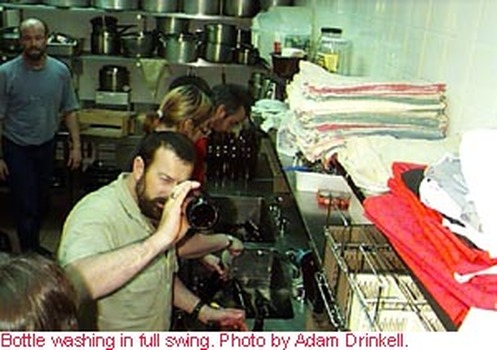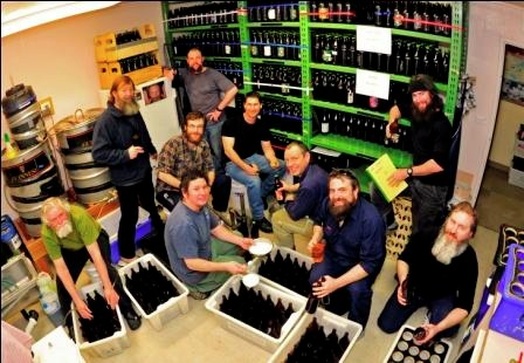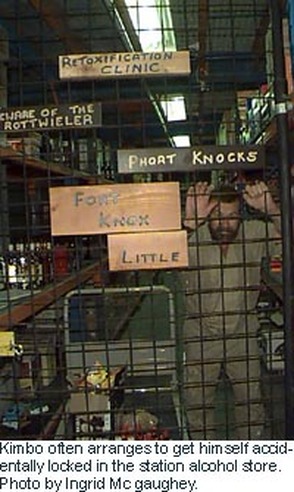- AGM - General Information
- AGM - Nominating for Council
- Message from the Club President
- About Our Club
- Club Management
- Our Branches
- Family & Friends Association
- Introduction to the Site
- News and Upcoming Events
- Melbourne MWD 2012 Images
- UK/Europe MWL 2012
- Photos from some Recent pre-2012 Dinners
- Nomination Form
- 2011 Medal Recipient
- Introduction
- Melbourne
- New South Wales
- Northern Territory
- Queensland
- South Australia
- Tasmania
- Links to Official Sites
- Links to Personal Pages
-
Gallery and Sound Bites
- Obituaries and Member Tributes
- Shelagh Robinson
- Alf Howard
- Dr Phil Law
- Classified Ads and Similar
- Gallery and Sound Bites
- Macquarie Island Field huts
- Brewing beer on station
- Masons Hut in miniature
Mawson 1998

Mawson Kitchen.
From front to back:
Kim (Kimbo) Barnsley, Ashleigh Wilson, Andrew Brooks, Michael Keam
The whole 'home brew' bottling extravaganza runs over 2 weeks. Brooksy, Ron and Peter, our 'brew masters' keep an eye on the stocks and decide when to make more beer. Looking through the log books, most years bottle 3 or 4 times, capping around 400 bottles on each occasion.
We have bottled twice already this year - in February and March, to replenish stocks after summer. This was our third bottling - not so much because stocks were low (apparently we've drunk very little over winter) but more to have a large number in reserve for the summer onslaught and beyond. The bottles, which have been bought from Boy Scout Associations over the years and shipped down, number around 1700. Of these about 1000 are currently empty.
Everyone pitches in at one stage or another although there are a few 'die hards' who just love to be present at every stage of the beer making process. This includes the initial drinking of the beer, subsequent rinsing of the bottle with water and storage in the Red Shed basement.
There comes a time when Brooksy declares a 'Great Bottle Washing' night. All 400 are bought up to the kitchen, scrubbed and washed in a sodium metabisulphate solution. It's a fast moving operation with the teams of washers often 'competing' to get the most washed. There's a lot of rivalry, laughter and splashing. (Well perhaps not too much official splashing as water restrictions are in place and the plumbers have beady eyes.) The bottles are then drained, dried and stored in the basement under plastic to protect from dust.
We have bottled twice already this year - in February and March, to replenish stocks after summer. This was our third bottling - not so much because stocks were low (apparently we've drunk very little over winter) but more to have a large number in reserve for the summer onslaught and beyond. The bottles, which have been bought from Boy Scout Associations over the years and shipped down, number around 1700. Of these about 1000 are currently empty.
Everyone pitches in at one stage or another although there are a few 'die hards' who just love to be present at every stage of the beer making process. This includes the initial drinking of the beer, subsequent rinsing of the bottle with water and storage in the Red Shed basement.
There comes a time when Brooksy declares a 'Great Bottle Washing' night. All 400 are bought up to the kitchen, scrubbed and washed in a sodium metabisulphate solution. It's a fast moving operation with the teams of washers often 'competing' to get the most washed. There's a lot of rivalry, laughter and splashing. (Well perhaps not too much official splashing as water restrictions are in place and the plumbers have beady eyes.) The bottles are then drained, dried and stored in the basement under plastic to protect from dust.
Inspired by our enthusiasm, the brew masters then make up the beer. You probably know all this but I thought I'd outline the highly secret Mawson Home Brew Technique, codenamed MHBT.
Alternatively you could read the back of the tin can the brew kit comes in.
Generally we combine the contents of 7 cans with 7 kilograms of sugar dissolving the two in 10 litres of hot water. An additional 150 litres of cold water is then added to the 'fermenter', a 200 litre stainless steel drum with an air tight lid and fitted air lock. After mixing, 3 sachets of brewer’s yeast (thoughtfully provided by the company) are added, the drum sealed and the whole lot left to ferment for between 7-10 days. Fermentation is complete when there is no more gas bubbling in the air lock and the specific gravity of the mixture is less than 1.006.
Once this stage is reached the word goes out once again. The actual bottling of the beer is very relaxed. Firstly a teaspoon of sugar is added to a clean bottle which is then filled with fluid from the fermenter. The bottle is sealed with a metal cap (my favorite job) detailing the type and batch no, inverted four times (the worst job because juggling them is distinctly frowned upon by Brooksy) and stored until required.
Most of the home brew is lager, although we also make small quantities of stout, draught and black and tan (a mixture of lager and stout). This time cider was brewed as well.
The majority of the beer is consumed over summer when there is an influx of people (station numbers more than double) and there is much more of a party atmosphere at night. In addition we often get one or two cruise ships visiting during the summer season. The visitors usually wind up at the bar after a tour of the station and are shouted a few drinks.
Alternatively you could read the back of the tin can the brew kit comes in.
Generally we combine the contents of 7 cans with 7 kilograms of sugar dissolving the two in 10 litres of hot water. An additional 150 litres of cold water is then added to the 'fermenter', a 200 litre stainless steel drum with an air tight lid and fitted air lock. After mixing, 3 sachets of brewer’s yeast (thoughtfully provided by the company) are added, the drum sealed and the whole lot left to ferment for between 7-10 days. Fermentation is complete when there is no more gas bubbling in the air lock and the specific gravity of the mixture is less than 1.006.
Once this stage is reached the word goes out once again. The actual bottling of the beer is very relaxed. Firstly a teaspoon of sugar is added to a clean bottle which is then filled with fluid from the fermenter. The bottle is sealed with a metal cap (my favorite job) detailing the type and batch no, inverted four times (the worst job because juggling them is distinctly frowned upon by Brooksy) and stored until required.
Most of the home brew is lager, although we also make small quantities of stout, draught and black and tan (a mixture of lager and stout). This time cider was brewed as well.
The majority of the beer is consumed over summer when there is an influx of people (station numbers more than double) and there is much more of a party atmosphere at night. In addition we often get one or two cruise ships visiting during the summer season. The visitors usually wind up at the bar after a tour of the station and are shouted a few drinks.
The home brew is really used to supplement our own personal supplies of alcohol. Think how it is at home - whether you're partying, at a BBQ, hosting a formal dinner, celebrating a birthday or enjoying a quiet time with friends - many adults would have at least one alcoholic drink and often more.
It's no different here. In fact the only difference is we can't just zip out to a bottle shop, pub or restaurant to buy what we want. Instead we have to purchase all our alcohol a year in advance and ship it down with the general station cargo.
Even then you can't bring in unlimited amounts. There is a basic restriction of one cubic metre on the amount of personal luggage you are allowed to take to the station. While there is some flexibility in the amount, there's not that much flexibility! Still the Division helps out - supplying a small amount of wine and spirits for the group - these are usually put out for Saturday night dinners. In addition we receive a carton of beer each month, although that privilege is soon to cease. These stores are kept over in 'Fort Knox' in the Green Store and distribution organised by Kimbo.
I think a fair proportion of the carton beer disappears at Friday 'after work' drinks. The drinks are a bit of a tradition here. Held most Friday nights before dinner, a different work area is responsible for hosting them each time. Several weeks ago it was Met (always a favorite as Ash and Maria always make yummy 'finger foods'), last week it was held in the new cool room which is being constructed. This Fridays was a classic.
The Diesos are currently servicing the 'Seeka' in the Red Dwarf workshop, our 7 metre mono-hulled boat. They decided to host drinks in the boat... one of our more exotic locations. Lifejackets were optional for once.
Writing about alcohol on station is like stumbling through a minefield. I think as a group we have a fairly balanced attitude. Although it doesn't dominate our social life, it's a part of our life...
Excerpt from ‘Ingrid on Ice’ , ABC website, 22/8/1998
It's no different here. In fact the only difference is we can't just zip out to a bottle shop, pub or restaurant to buy what we want. Instead we have to purchase all our alcohol a year in advance and ship it down with the general station cargo.
Even then you can't bring in unlimited amounts. There is a basic restriction of one cubic metre on the amount of personal luggage you are allowed to take to the station. While there is some flexibility in the amount, there's not that much flexibility! Still the Division helps out - supplying a small amount of wine and spirits for the group - these are usually put out for Saturday night dinners. In addition we receive a carton of beer each month, although that privilege is soon to cease. These stores are kept over in 'Fort Knox' in the Green Store and distribution organised by Kimbo.
I think a fair proportion of the carton beer disappears at Friday 'after work' drinks. The drinks are a bit of a tradition here. Held most Friday nights before dinner, a different work area is responsible for hosting them each time. Several weeks ago it was Met (always a favorite as Ash and Maria always make yummy 'finger foods'), last week it was held in the new cool room which is being constructed. This Fridays was a classic.
The Diesos are currently servicing the 'Seeka' in the Red Dwarf workshop, our 7 metre mono-hulled boat. They decided to host drinks in the boat... one of our more exotic locations. Lifejackets were optional for once.
Writing about alcohol on station is like stumbling through a minefield. I think as a group we have a fairly balanced attitude. Although it doesn't dominate our social life, it's a part of our life...
Excerpt from ‘Ingrid on Ice’ , ABC website, 22/8/1998
Casey 2010

Photo by Amy Bulters
Is anyone able to provide additional information re the beer brewing process at this time -if so please write to me.
Ingrid McGaughey
Ingrid McGaughey


